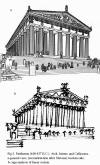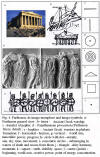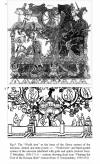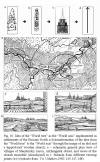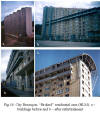 |
Urban Bodies | |
| Vol. 7, No. 1, (September 2002) |
|
___Alexander
A. Barabanov Yekaterinburg |
Man and
Architecture: Semantics of Relations |
Many investigators have been turning to the city as a phenomenon of architecture in an attempt to disclose their semantic nature. Cities are compared to speech (Barthes, 1970:12), language, chronicles in stone (Hugo, 1925: 204-205), theatre, poem (Barthes, 1970: 13), man and human body (Vazari, 1956; Brinkmann, 1935). It is also a known fact that in Ancient Greece, Ancient Rome and in the period of Renaissance classical orders construction was related to the proportions and images of man’s and woman’s bodies.
There exist the proportioning systems, which found
application in architecture
during the Renaissance and the 20th
century, being also based on the proportions of human body: the “Square of
proportions” of Leonardo da Vinci and the “Modulor” of Le Corbusier (Shmelev,
1990: 290).
The whole of the object-and-spatial environment incessantly built by people appears as a distinctive materialization of socio-political, ideological and cultural-and aesthetic aspirations of human society. Through materialization in the architectural-spatial environment, society leaves its anthropomorphic trace, reflecting direct and indirect interrelations between man and his environment, between human ideas, intentions, bodies, human organism proper and the architectural-spatial environment, rich in volumes, shapes and volumes. Even these interrelations manifest themselves in the interaction of the significative and the signified, with the latter able to act both as a denotatum and a connotatum.
In human perception,
the urban architectural-and-spatial
environment acts as a system of mutually replacing and interacting
emotional-aesthetic signs, symbols and images recognized in architectural
bodies. This system
causes and determines the emotional-aesthetic, symbolic and
figurative perception of the
image of the world by man . Directly or indirectly, all the object-spatial
world surrounding man acts on him. At that, from 85 to 90 percent of information
about the surrounding world comes to humans
by vision, while only 10-15 percent,
by the senses of hearing,
smell, touch and kinaesthetic
feelings (Barabanov, 1991, 1992, 1997).
Lines and
Emotions
It is known and visual perception by man of shapes and volume is based on three main levels: signaling (collective unconscious), figurative (individual unconscious), and symbolic (collective conscious) (Barabanov, 1998, 1999).
Knowing the peculiarities of visual human perception, Ancient Greeks, back in the 5th century B.C., used curvatures, which took into account the optical distortions of human perception, for better presentation and perception of architectural constructions, e.g., Parthenon on the acropolis at Athens.
Many investigators wrote about the psychological effect of shape on man and his behavior. Aesthetic expressiveness of lines, planes, color, spaces and volumes making up shape as a basis of emotional influence on man was investigated by psychologists and aesthetics of the 19th century, such as: G. Fechner, V. Helmholtz, V. Wundt (Korotkovsky, 1975:7; Belyaeva, 1977:78).
John Simonds, in his book “Landscape and Architecture”, writes: “Line, shape, color, quality, sound, smell – all of these call forth definite emotional reactions. If, for example, an outline produces some kind of effect on viewer, this is sufficient reason to use such outlines in forming such structures or volumes which would cause the same reaction in viewers (J. Simonds, 1965:78).
The prominent French architect of the 20th century Le Corbusier noted special importance of the simplest elements making up an architectural form in the emotional effect on man, and underscored the need for investigating their emotional effect, conscious selection and use: “The view of various lines I am drawing on this blackboard calls forth just as many different feelings: the view of a broken or a continuous line produces certain effect on the nervous system itself. We get agreeable or disagreeable impressions from the lines perceived with our eyes. If we begin investigating the effect of these impressions on our ability to feel, with will come to being selective: one line tires us, the other line pleases; this system of non-interconnected lines excites us, and that rhythmic system calms us down; very soon you will see that selection goes spontaneously, and certain preferences get established, in them one would inevitably come to a conclusion that artists permanently select those lines and shapes which satisfy our senses. In this sphere of lines and shapes satisfying our senses, we again get proof of the omnipotence of harmony. What are the moments of aesthetic effect in architecture? The ones perceived with our eyes. What does our eye perceive? Surfaces, shapes, lines. So, the point is that from all parts of an architectural piece it is necessary to create a unity arising aesthetic excitation, a unity of shapes making it, spiritualizing it, attributing to it the relations and proportions between their parts which give our senses the impression of orderliness." (Le Courbusier, 1924) It is known that often the perception of totally different architectural objects and volumes often causes similar emotions and feelings as a human response to an object. The common aspect that brings together those different objects is not just their shapes, volumes, elements etc., but even more – the feelings. The emotional-aesthetic is both the beginning and the ultimate goal in the architect-consumer chain, if we consider architecture as an art, since “… each work of art would be naturally regarded by a psychologist as a system of irritants, consciously and thoughtfully organized with a view to cause an aesthetic reaction. At that, analyzing the structure of irritants, we re reconstitute the structure of a reaction” (Vygotsky, 1986:39).
As was established by experimental psychology, the
emotional effect of one or the other lines on man is, on the one hand,
connected with the work of a human eye. For example, a horizontal line is
perceived by an eye with minimum strain, thus causing the feeling of pleasure and
satisfaction. A vertical line is perceived with greater strain. Irregular and
broken lines cause maximum strain and painful feelings in the eyes, since eye
muscles are made to change direction suddenly, without preparation. In
perceiving regular curved lines, the eye gets prepared to the anticipated
change, and this causes the feeling of satisfaction.
On the other hand, kinaesthetic feelings (i.e., feelings caused by movement of separate parts of a human body) strengthen and intensify the emotional effect of lines, surfaces, shapes on man. So, horizontal lines of a plane give an opportunity to move along them with minimum effort. A vertical line offers a direction, and unconsciously, man tries to keep his body parallel to it, keeping balance and overcoming gravity. At that, compared with the static character of horizontal lines, a vertical one carries a “charge of potential movement”. Slanted lines and planes possess dynamic properties, since they arise the need for keeping balance (Belyaeva, 1977:33-34, 44-45).
Which feelings, emotions, associations and ideas does perception of one or the other lines and directions arise in man? A horizontal line, a direction, gives the feeling of peace, strength, lightness, freedom, safety, balance, passiveness, monotony, heaviness (in a respective context). A vertical line in the direction upwards creates an idea of rise, growth, activity, feeling of victory over gravity, new opportunities. A descending vertical line creates a feeling of defeat, retreat, refuge, shelter, solitude, agreement with gravity, ever increasing limitation, feeling of depression. Diagonal and regular lines incarnate active movement, dynamics. Depending on the direction of the diagonals and regular curves either upwards or downwards, the basic feeling of dynamic active movement is supplemented with the feelings caused by vertical and horizontal directions (fig. 1) (Simonds, 1965:128). Thus, perception experience determines the direct emotional effect of lines, planes and shapes and generate habitual associations.
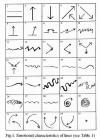
Table 1:
1
-
rest,
equilibrium;
1а
-
passive, light, free, earthly, safe, satisfied, monotonous;
1b
-
heavy, reliable, bold, strong, firm;
2
-
noble, dramatic, inspiring, exalting, ascending, rising, growing, overcoming
gravity;
3
- defeated, retreating, falling, depressive;
4
-
rising, active, dynamic, overcoming;
5
-
descending, sliding, dynamic, returning;
6
-
stable, reaching upwards;
7
- unstable/stable, falling/ascending (depending on “contour/background”
context);
8
-
constructive, solid, strong;
9
- active, dynamic, insistent;
10
- coarse, gritting, irritating;
11
- excited, nervous, frightened;
12
-
dented, coarse, rough, energetic, courageous;
13
-
decreasing, shrinking, contrary, closing;
14
-
increasing, expanding, diverging, opening;
15
-
scattering, disappearing;
16
-
converging, condensing, concentrating;
17
- uncertain, wavering;
18
-
refined;
19
-
flowing, smooth, soft; 20
-
curvilinear, tender, soft, pleasing, feminine;
21
- primitive, simple, smooth, bold;
22
-
calm, sliding, soft;
23
-
progressive, steady, intensifying;
24
-
regressive, unsteady, slackening;
25
-
blazing, agitated;
26
- expansive, elastic, repetitive;
29
- unfolding, leaving, disappearing;
30
-
folding, condensing, concentrating;
31
-
active, dynamic, rising with deceleration;
32
-
dynamic, sliding with acceleration;
33
-
active, dynamic, rising with acceleration;
34
-
dynamic, sliding with deceleration;
35
-
static, focused, steady in movement.
Symbolism of
Lines, Shapes and figures
Lines and the shapes and figures they form, beside emotional expression, bear a deep symbolic meaning connected with their emotional-aesthetic content. Let us consider the symbolic content of the lines, shapes and figures shown in fig. 2, which are quite often met in architecture. In their interpretation, use was made of glossaries of symbols (Chevalier et Gheerbant, 1988; Bauer et al., 1995).
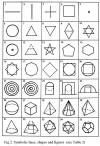
Table 2 (Explanatory):
1- horizontal; 2 - vertical; 3 - cross; 4 - square; 5 - center (point); 6 - circle, circumference; 7,8 - triangle: 9 - rhomb; 10 - hexagram, six-pointed star, “Solomon’s seal”, “David’s shield”; 11 - circle with central point; 12 - trapezium; 13 - pentagram, five-pointed star; 14 - regular pentagon; 15 - regular hexagon; 16 - eight-pointed star; 17 - regular octagon; 18 - dynamic square; 19 - circle inscribed in square; 20 - square inscribed in circle; 21- concentric circles; 22 - spiral; 23 - square completed with arch; 24 - square united with arch; 25 - square embraced with arch; 26 - sphere, ball; 27 - cube; 28 - tetrahedral pyramid; 29 - octahedral pyramid, hipped roof; 30 - tetrahedron; 31 - cone; 32 - obelisk; 33 - octahedron; 34 - icosahedron; 35 - dodecahedron.
Horizontal – ancient symbol of horizon, earth surface.
Vertical – simplest strong symbol of ascent and progress, of active, working principal element of the creation and a symbol of masculine force, masculine behavior, associated with lingam (phallus). A symbol uniting the upper and the nether worlds.
Cross – one of the four fundamental symbols, including square, center and circle. Depicts a unity of the four elements, a material world, synonymous of a physical object. A symbol of the earth with the four sides formed by the four elements. Also a symbol of sufferings of Christ crucified. The basis of all orientation symbols: spiritual orientation – the East-West axis. Time orientation – the axis of rotation, North-South, bottom-top. A symbol of the tree of the universe, the tree of life, synthesis and measure, union of the sky and the earth, space and time.
Square – one of the four fundamental symbols. A symbol of the earth as an opposite to the sky; also a symbol of a created universe – space; an anti-dynamic figure, symbolizing a stop, an isolated moment, an idea of stagnation, freezing. In all astrological traditional notions, a square denotes earth, matter, limitation.
Center (point) – one of the four fundamental symbols. A symbol of the beginning, absolute reality, a place of condensing and implementation of opposing forces, concentration of maximum energy. The axis of the universe connecting the sky, the earth and the nether world passes through the center. A symbol of creative power and end of all things.
Circle – one of the four fundamental symbols. A symbol of movement (wheel), the sky, the infinity, the universe, time, protection ensured within its boundaries. It presents an expanded point (center) with the same symbolic properties. Associated with the cult of fire, heroes, god. In Christian mythology, a circle denotes eternity.
Triangle – very often used in ornamental friezes of India, Greece, Rome. Its meaning seems permanent. A triangle with an apex up symbolizes mountain, fire and masculine creative power; a triangle with an apex down symbolizes cave, water pouring from the sky and running down from the mountains, a fertile bosom and feminine nature. An equilateral triangle symbolizes god, harmony, proportion.
Rhombus – a feminine symbol. It is associated with an erotic meaning. It carries dualist philosophy, and symbolized entrance to residence of the forces beyond the grave. In a strongly stretched form, two isosceles triangles, forming a rhombus with their joined bases, mean contacts between the sky and the earth, between the upper and the nether worlds, even, at times, union of the two sexes.
Hexagram – the so-called “star, or shield, of David”, “Solomon’s seal”, presenting an ensemble of the elements of the Universe. It is formed of two superimposed triangles and means the union of the creative and birth-giving natures. At that, a triangle of fire truncated with the base of a triangle of water means air; and vice versa, a triangle of water, truncated with the base of a triangle of fire corresponds to the earth. So the hexagram presents a synthesis of the opposites and an expression of cosmic unity, and simultaneously, its complexity.
Circle with central point – in astrology, symbolizes the sun; in alchemy, gold; possesses the symbolic properties of a circle and a center. Similar to itself, without beginning and end, a perfect circle is a sign of the absolute.
Trapezium – a call to movement. Being considered as a truncated triangle, it produces an impression of independence, irregularity, or fault.
Pentagram in the form of a five-pointed star has plural symbolism based on the number of 5 standing for a union of unequals, thus symbolizing microcosm. The pentagram five rays form a fruitful unity of the number of 3 denoting masculine nature, and the number of 2 corresponding to feminine nature. In the ancient world a pentagram was a symbol of high science, knowledge, opening a road to secrets. The ancient believed it to be a symbol of a perfect idea. A pentagram also means happiness, wedding, fulfillment, power, a fact of synthesis of complementary forces.
Hexagon, in Christian symbolism borrowed from antiquity, stands for the figure of death. Hexagon is connected with an image of burial of a sinful creature – a prelude of turning into a noble creature. Hexagon, linked with the symbolism of the figure of 6, acts as an opposition of a creation to the creator in infinite balance, and expresses the number of testing between good and evil. The Mayas believed 6 to the fatal number, and it denoted the day of death.
Octagon (eight-pointed star) symbolizes revival, resurrection. According to Christian symbolism, octagon revives in memory the ideas of eternal life, which is reached through dipping a neophyte in a font at baptizing. A hexagon related to the figure of 8 expresses a universal number of cosmic equilibrium. Hexagon acts in the capacity of an intermediary between square and circle, between the earth and the sky, hence it is related to an intermediate world.
Dynamic square – a square turned to 45º, losing its static character, acquired dynamics, and its symbolism become close to rhombus.
Circle inscribed in square – a cabbalistic symbol. It denotes a spark or celestial fire hidden in matter and enlivening it with a fire of life.
Square inscribed in circle brings forth the idea of movement, change of order or level. A circle combined with a square is spontaneously interpreted by human psychology as a dynamic image of dialectics between the lofty sky and the earth.
Concentric circles, carrying the symbolism of a circle, a center, acquire additionally the symbolism of a ring appearing as a symbol of union, promise, community; they also express the dialectic relations between master and slave, joining and isolating at the same time. Quite often concentric circles are treated as symbols of submersion in the waters of death, as well as rescue from them.
Spiral symbolizes origin, expansion, development, cyclic and progressive continuity, creative rotation. Spiral personifies evolution of power and movement, emerging from the original center and directed to infinity. Spiral is linked with cosmic symbolism of the Moon, symbolism of fertility, reiterations of the rhythms of life, the cyclic nature of evolution, the permanence of being at transiency of movement.
Square completed with an arch is the basis of a cube-and-dome structure often resorted to in architecture and arts of different people. This combination materializes the dialectics of interrelations between the sky and the earth, imperfection and perfection, man and God.
Square linked with an arch presents a complicated form provoking break of rhythm, line, level and inviting to seek movement, change, new equilibrium. This form, symbolizing inspiration with an external world or the level of a higher life, becomes a classical example of a triumphal arch, personifying victorious passage of heroes, as if they were stepping onto a different path of life, similar to the life of a gods expressed in its power, wisdom and holiness.
Square surrounded with an arch (fragment of a circle) reflects a dynamic image, the dialectics between the lofty sky and the earth, perfection and imperfection.
Sphere, ball possess the symbolism of a circle, and from ancient times personify perfection and oneness. In architecture, a sphere is often reduced to a semi-sphere, yet bearing the same symbolic meaning. Transfer from cubic to spherical shapes, from square to circle symbolizes transition or return from the created to the uncreated, from the earth to the sky, and denotes fullness of completion, perfection of a completed cycle.
Cube – “square of squares” – among volumes, it bears the same meaning as a square among flat figures. It symbolizes material world and ensemble of the four elements. Due to its static character, cube is regarded as a symbol of stability. In the mystical sense, cube is a symbol of wisdom, truth and moral perfection. Combined with a sphere, cube symbolizes celestial and earthly oneness, union of the finite and the infinite, the created and the uncreated, the top an the bottom.
Tetrahedral pyramid possesses the symbolism of a square, a triangle and a center. It is an image of the an elevating convergence and ascension. Pyramid is also a symbol of a reunion of the two worlds material and spiritual, earthly and celestial. In Ancient Egypt, pyramid was a powerful symbol personifying existence and bearing an idea of absolute divine power of a deceased pharaoh, whose soul ascends freely to the sky and comes down at will.
Octagonal pyramid (hipped roof) conveys the symbolism of an octagon , a triangle and a center. . Personifying ascension, hexagonal pyramid presents a refined symbol of reunion of the two worlds: earthly and celestial. Hipped roof is a popular element in Old Russian architecture.
Tetrahedron (triangular pyramid) carries the symbolism of a triangle and a center, and in presents fire geometric symbolism.
Cone – a geometric body uniting the symbolism of a triangle, circle and center. The symbolism of a cone is close to that of a pyramid related to an image of ascension and evolution from material to spiritual, to an image of progressive spirituality of the world, return to unity, as well as to the image of femininity.
Obelisk – a geometrical body combining the symbolism of a rectangle, a trapezium, a triangle and a vertical.
Octahedron – a regular polyhedron, with faces of 8 triangles, it represents air in geometrical symbolism, and unites the symbolism of a triangle, a rhombus and a vertical.
Icosahedron – regular polyhedron, with faces of 20 equilateral triangles, represents water in geometric symbolism.
Dodecahedron – regular polyhedron, with faces of 12 pentagons; it plays the role of a medium for the whole of the Universe. It is not just an image of the Cosmos, it represents its number, its formula, its idea, and its essence. It expresses development of the Universe and presents a geometric symbol of outstanding value.
Comparing the semantic content of single elementary lines, shapes and figures with their symbolic meaning, we see that their symbolism in many aspects relies on their emotional-aesthetic content.
Vector
Semiotics: Emotional-Aesthetic Signs in Architecture
Note that contour line-vectors visible in a shape, on its surface and at junctions of shapes and volume possess extraordinary expressive qualities. Interacting, interweaving between themselves, they create a peculiar emotional harmony of an architectural piece.
Consider, for example, the vector-line system of one of the outstanding monuments of the world architecture, the temple of Parthenon built on the Athens acropolis (447-438 B.C., architects Ictinus and Callicrates) (fig. 3).
From the powerful stereobate underscored with rows of repeating steps, producing a general feeling of peace, satisfaction and strength, bunches of vertical lines rush upwards, and line-vectors of the fluted columns converge above generating the feeling of noble loftiness and exaltation, with a subsequent halt and distribution in column capitals. Peace, strength and reliance of the architrave give way in the frieze to metrical alternations of verticals, grooves, triglyphs and dynamic curves, with accentuated centers of the metopes. Then there follows a stop on the calm line of the crowning cornice, over which unfold, in an antagonism that intensifies towards the center, the rippling powerful lines of reliefs of the tympanum and the enframing them on top slanted cornice lines of the pediment. Their beginnings and ends are marked with the dynamic lines of acroteria, the sculptural ornaments of the pediment. At that, an ultimate feeling of strength, nobleness, reliance, exaltation and balance is born in the whole system of interacting line-vectors and shapes.
If we break down the vector-line order of Parthenon to separate elements, we will obtain an abstract expression of lines, the so-called “glossary” or “ABC” of the emotional level of the artistic language of this architectural masterpiece. Each line of Parthenon, conveying one or the other feeling, switch into the work adding to the overall emotional tone filled with heroic pathos.
It should be noted that the spatial-temporal aspect of perception of architectural shapes and volumes is not in the least contradiction with the above. Alternation of close and remote sights, a sequence of viewer’s frames are accompanied with respective alternation and change of one emotional-line vector order with the other, with respective development, superposition and variation. It may be added that emotional value of contour line-vectors is an inalienable feature not of architectural works only, but also of painting, drawing, sculpture etc., i.e., of any visually perceiver shapes, figures and volumes. This, in particular, explains the emergence of certain sensations, emotions and feelings in perception of the works of “objectless” painting, pop-art etc. Considering, in terms of semiotics, the line-vectors organizing the emotional order of an architectural object, a complex, a city, with their abstract expression, we approach the problem of emotional-aesthetic sign in architecture. Because lines making up forms act as emotional-aesthetic signs, those unit signs of the “ABC” of the emotional level of the language of art, which actively influences formation of a synthetic image. At that, one should be able to tell art images from a synthetic image, created in human mind as a result of interaction of emotional-aesthetic signs building up an emotional line-vector system of an architectural form, the symbols and series of associative images acting as metaphors.
Form lines are the emotional-aesthetic signs personifying certain sensations, ideas, phenomena, human virtues and ideas, appearing as kind of substitutes to some phenomena of the reality. Besides, they possess stable value, invariance of their meaning and act as “archetypes”, the “unexpandable units of the unconscious”. Such is the objective side of human perception of architecture.
Images in
Architecture
Formation of a synthetic image and the emotional order of one or the other work of architectural art undergoes the influence of both the emotional-aesthetic signs – line-vectors with their abstract emotional expression, and the integral visual images (mainly anthropomorphic and animalistic). They act as specific working units of perception at the stage of secondary (mental) reflection of reality, superimposed on the visual image obtained on the eye retina (copy-objective reflection of reality), since any perception process “… goes as an interaction of two contrary flows: one from an object, the other from the depth of memory of an individual as a result of reflection of his former perception experience” (Korotkovsky, 1975:43).
The combination of simple and complex images as well as the different kinds of memory involved in the process of human perception allows both the architect-creator and the perceiving consumer, to reconstruct and create new images, which, together with emotional-aesthetic signs and symbols make the basis of a synthetic image. Note that the image-bearing system of architecture is strongly dependent on subjective factors of perception, such as the specific features and virtues of a person, ability to aesthetic perception, orientation to perception, emotional state, etc.
Let us now consider the relation between emotions and image on an example of analysis of image content of the above work of architecture. The image-bearing system of Parthenon is based on anthropomorphic nature of columns of the Greek-Doric order, its association with an athletic masculine figure. Looking at the rectangular volume enframed in Doric columns of the temple facing the viewer, one easily recognizes in it the image of a Greek phalanx, the combat formation in which warriors, the hoplites, armed with spears and hiding behind round shields (ornamented circles-shields over the abacuses on top of each column, decorating architrave beams over the whole building perimeter), march in formation of geometrically accurate rows to meet the enemy (fig. 4e).
The Image of Parthenon is connected, by association and directly, with Panathenaean procession – a ritual procession held every fourth year at the time of the Great Panathenaic festival, culminating in a ceremony of handing over new robe sewn for the statue of goddess Athena. The extended southern and northern façades of Parthenon call forth an image of slow, rhythmic and festive procession of the people carrying gifts, while the end sides, the eastern and western façades, create images of termination of a festive ceremony of transfer of the newly woven robe, the peplos (fig. 4 c, d). The swift thrust of the temple volume on viewer is also associated with an image of a Greek triera – a warship with sail and oars arranged in three tiers on both sides of the ship (fig. 4b). The sameness, metric rhythm and symmetry of columns-people on the façades of Parthenon also convey an idea of equality of citizens of a Greek democratic polis, while the free winding road to the temple and the angular view, free from symmetric axial arrangement and characteristic of perception of Greek architecture in general and in this particular case, convey a visible idea of freedom. The impression of a festive spirit, nobleness, evident but restrained power and calm coming from the lined order of Parthenon is related to a similar emotional expression of its quite tangible images, thus forming an integral and polysemantic synthetic image.
The symbolism of lines, shapes and figures used and visible in the architectural-compositional system and decoration of Parthenon supplements and develops the emerging polysemantic image (fig. 4f-I). The horizontal line multiplied in the stereobate lines, personifying solid earth, is underscored by a powerful horizontal line of the architrave, behind which guesses a plan rectangle, also personifying the earth opposed to the sky, solid strength and stability. The vertical line symbolizing activity, masculine strength, progress and ascension is multiplied in the columns of the peripter and adds up to the emerging image with a many-times repeated image-symbol of a union of the upper and nether worlds. Circles with a marked center, which were used in the decoration of architraves over column capitals, symbolize the triumph of heroes and gods, infinity of the Universe and time, of movement and protection. And finally, the triangles of the western and eastern fronts of Parthenon completing the end sides of the temple, by symbolizing courage, mountain (Olympus?) and fire crown this complicated hierarchy of the symbolic order of Parthenon, by intensifying and fixing in mind the great creative power, wealth and polysemantism of the emerging synthetic image[1].
As distinct from emotional-aesthetic signs possessing relative invariance of meaning, one of the specific features of a “synthetic image, beside other features, consists in that it is able to attract and absorb new phenomena of the reality, often chronologically quite remote from those which had served as an their original source (Khrapchenko, 1982:307). An image is apt to changing in time, since it is determined by the whole socio-historical experience of mankind. Note also that expressiveness of emotional-aesthetic signs and their relation to reality expressed in images, despite their inequality, undoubtedly make them close to one another and, as was noted in the analysis of expressive system, at times merge them in one whole as, for example, in Parthenon. Note also that in some architectural structures emotional-aesthetic signs, in others, images may dominate.
Semiotic
Significance
of the Means of Architectural Composition
The present paper treats only a few of the aspects of semiotics of the language of architectural art. Certainly, semiotics of architecture is not limited to emotional system, figurativeness and symbolism, since light and color, relations between shapes, volumes and masses, rhythm, scale, proportions, contrast and nuance, symmetry and asymmetry of forms, material and texture of surfaces, tectonics, etc. also influence the aesthetic evaluation and the emotions proper, and, in the final run, they influence the structure of a synthetic image (Belyaeva, 1977:47-49; Ikonnikov and Stepanov, 1971; Ikonnikov, 1985).
For example, restrained white colors bring forth the idea of the sublime, the spiritual. Bright warm colors and glimmering light correspond to merriment, while cool blue and green colors, pale and quivering or incinerating light cause fear. Curving shapes and volumes relieve tension; free shapes and volumes promote merriment; isolated small volumes, the feeling of seclusion, and contemplation. Amazing scale, exceeding normal human conceptions, gives the feeling of the lofty. Lack of means to change scale causes fear. A clearly expressed rhythm causes merriment; lack of rhythm and monotony displease. Hard rough or dented surfaces cause strain; smooth surfaces, merriment. Contrast between high-soaring shapes and low horizontal forms causes the feelings of the lofty, spiritual, etc. (Simonds, 1965:68-70).
Despite the fact that the means of architectural composition exert direct influence on perception, their main purpose is to convey the aesthetic aspect of an architectural form. The means of architectural composition may, to a certain degree, be compared to a set of grammatical rules, the syntax and “grammar” of the language of architectural art, in compliance with which an architectural form acquires its aesthetic value, and consequently, additional artistic meaning.
Myths, Symbols
and Images as a Basis of Perception – Reading a City
Up to our days, mengirs (stones set up vertically), the “precursors of cities” expressing the power of human being, are being found in every part of the world. Beside a series of more utilitarian meanings, they display to us an image of a center, one of the fundamental symbols of mankind.
They are the symbol of the beginning, absolute reality, the point of condensation and coexistence of opposite forces, of the most concentrated energy. The “world axis” passes through the center, connecting the sky, the earth and the nether world. It a symbol of creative power and the end of all things (Chevalier et Gheerbrant, 1988:198-190, 622; Barabanov, 1998: 110).
Historical and architectural sources give evidence of the majority of the first Egyptian, Mesopotamian and other cities presenting a circle, which, with time, was replaced with squares or rectangles close to square (Lagopoulos, 1995; Bunin, 1979).
It is known from the symbolism of shapes and figures that circle is one of the fundamental symbols, demonstrating am idea of the cosmos; a celestial dome, unity, infinity and completion, the peak of perfection, movement, the wheel of time (Chevalier et Gheerbrant, 1988:191-195; Toporov and Meilach, 1994-v.2:18-19; Barabanov, 1998: 110).
Square – also one of the four fundamental symbols conveying the idea of a quadrilateral figure, orientation, absolute equality, simplicity, law, order, truth, justice, wisdom, honor, terrestrial stability, reliance, immobility (Chevalier et Gheerbrant, 1988:165-169; Toporov, 1994-v.1:630-631; Barabanov, 1998: 110) . By relating the forms of ancient cities to their cultural and symbolic meanings, it may be assumed that the form of a round city must normally indicate that its first inhabitants had been nomads. Square or rectangular form of a city testifies to its inhabitants lived a settled life, with an intent to stay there long, or even for good.
From the “World
Mountain” to the “World Axis”
Architecture and urbanism of ancient civilizations (such as: Mesopotamia, Egypt, Near East, Central Asia, Indochina, Pre-Columbian America, and even Old Russia) were strictly regulated and stipulated by the volume-spatial and planning solutions of their myths and religious ideas. Due to this, they developed certain common and specific features, which manifested themselves in a specific manner in the course of development of ancient cities and settlements, as well as religious buildings, which reflected their vivid and figurative interpretation.
As we come to study the cosmological and cosmogonical myths of Ancient Sumerians, Egyptians, Indians and other peoples, we reveal much common in them. The main cosmogonical similarity is that the primary world presented a “liquid and crepuscular chaos”, from which there emerged a primordial hill (the mythical “world mountain”), and which then transformed into an image of a world axis (axis mundi), a cosmic pole, a world tree, etc.
This primordial hill (or the world mountain) is perceived as an image of the World, a model of the Universe, reflecting all elements and parameters of cosmic organization (fig. 5). The “world mountain is placed in the center of the world: at a point where the “world axis” passes. The axis continued upwards (through the crest of the world mountain) is marked with the position of the Polar Star; its continuation downwards points to the location of an entry to the Underworld (Hades). The base of the mountain is the “hub of the universe”. The world mountain has three parts. Gods live on its top. Evil spirits inhabit its foot – they belong to the realm of the dead. Humankind lives in its middle, the earth level (Toporov, 1994-v.1:311). A most classical type of a world mountain is Mere, the largest mountain in Indian mythology and cosmography. It is located in the center of the Earth, under the Polar Star, and is surrounded with the world ocean. Gods live on its three tops: golden, silver and iron. At its foot the kingdom of Assure is located. The four other mountains around it point to the cardinal points, they are covered with huge trees.
Myths about the creation of the Universe and Indian cosmology carry a holy symbol, known as “Mandala”, usually represented as a circle with an inscribed square. The square, in its turn, contains another inscribed circle: its periphery is traditionally marked with a lotus with eight petals, or eight parts, segmenting the circle (fig. 5a). The square is oriented to the cardinal points and colored according to the orientation of its parts. In the middle of each side of the square there are T-shaped gates. The cosmological interpretation of mandala treats the external circle as representation of the whole Universe in its unity. It sets the boundaries of the Universe and its spatial limits, also offering a temporal model of the Universe. This play of geometrical symbols (circle and square) is supplemented in mandala with the motifs of a ritual myth, according to which the Deity descends from the sky right in the center of the Mandala marked with a lotus, where it performs an act bringing fertility, abundance and success.
These mythic and poetical ideas of the structure of the Universe naturally found reflection in the architecture of many countries, influencing forms of cities, as well as in large religious town-planning complexes and architectural structures. That is why a pyramid, a ziggurat, a stupa, a pagoda, a hill-temple may be regarded as architectural images of the world mountain, its symbols and semblance (fig. 6, 7).
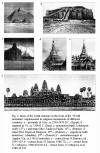 |
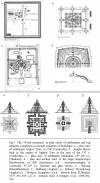 |
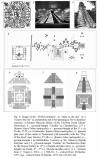 |
Evidently, the religious and town-planning complexes of Pre-Columbian America, despite the generally accepted mythical concept of world tree as the main structural scheme of the universe, carry the same visual symbols: of a “holy stepped mountain” representing “stairs to the sky” or a “road to the sky”, for the central Mayan, Incan and other Pre-Columbian American people’s deities to come down to the earth and ascend to the sky (fig. 8). One easily recognizes in their volume-spatial and plastic solutions the anthropomorphic images of the deities proper¸ to whom those structures were dedicated.
From the “World
Tree” to the “World Axis”
The image of the “world tree” played a special organizing role in the mythology of different peoples, presetting their temporal structure and principal parameters. The “world tree” is usually placed vertically in sacred center, getting transformed into the “world axis”, the center of the universe and a general idea of the universe.
This image unites the various coordinates of the world: vertical (the tree reaching from the earth to the sky) and horizontal (the path), both in the spatial and temporal sense. The following parts are recognized in the vertical section of the world tree: bottom (root), middle (shaft) and top (branches). In the image of the world tree, the three main zones of the universe designate the celestial kingdom (top), the earth (middle), and the nether world (bottom). They represent the spatial sphere. The world tree also reflects the notion of the past, the present and the future. It is the temporal sphere (Toporov, 1994-v.1:399) (fig. 9).
The most live and complete image of the world tree was realized in the Old Russian cities and villages. Until the 11th century, Old Russia was a heathen country. It had its own gods, among them: Perun, Stribog, Sventovit, Dazh'bog, Mokosh, Khors, Semargl, Svarog, Veles (Volos)[2]. Ritual ceremonies were held in holy places, in front of the images of these gods. Christianity came to Russia from only at the end of the 10th century. Despite strong Byzantine influence, the idea of the world tree and the images of ancient gods inevitably dominated in the forms and spatial compositions of settlements and religious complexes. As a rule, a church occupied the best location, visible from all parts of the settlement. The upwards-directed shape of a church roof, usually wooden, resembled a fir-tree, conveying the cultural idea of a “world axis”, and played an important religious and social role in the center of such a settlement (fig. 10).
Semiotic
Transformation of Images in Russian Architecture and Urbanism
On the length of the whole period of formation of the Russian state, the canonical image of a Russian church as the heavenly city of Jerusalem was being enriched with other image symbols and metaphors, as they got transformed from the “world tree” and “world axis” to anthropomorphic images, which changed with the prevailing social and cultural ideas of their time closely interwoven with two plots: religious and secular. So, one of the first stone cathedrals of Old Russia, the thirteen-cupola St. Sophia Church built in 1037 in Kiev by prince Yaroslav the Wise and dedicated to the Virgin, bore Christian image symbolism both in its exterior and interior: “Christ and His 12 Apostles” (fig. 11a, b). The specific anthropomorphic interpretation of the special composition of all thirteen cupolas of the church one naturally perceives the heathen heritage of the Russian history with the pantheon of the “assembly” of its gods (see Note 2), as well as memorial and secular ideas: memory of the victory in the war with the Pechenegi threatening the Kiev Russia, as well as a symbol of the “unity of christened Russian lands under Kiev” (Mokeev, 1978:52). It is a well known fact that prince Vladimir Svyatoslavich sent his 12 sons to 12 cities to baptize and unite all lands of the East-Slavic tribes. His son, Yaroslav the Wise, in fulfillment of his father’s will, left the concept of the church composition without change: 12 cupolas around the thirteenth, the central one, personifying prince Vladimir and his 12 sons and symbolizing unity of Russian lands. It may be supposed also that prince Yaroslav the Wise decided to personify the whole of his Christ-blessed family, including himself, in the volume-spatial composition of St.Sophia Church. The respective ceremony is represented in a mural inside the church (fig. 11c). The view of cupola tops of the cathedral, resembling prince’s fur-lined caps, points to the same.
We can mark the two main plots, religious and secular, in the canonical churches built in the 12th century in Vladimir-Suzdal lands of Russia as well. The first plot is connected with the image of Christ, because church as a whole was also called “the body of Christ”. The second plot begins with an image of a young and strong prince, as in the Church of the Pokrov (Intercession) on the Nerl' near Vladimir built in 1165 by prince Andrey Bogolyubsky in memory of his son Izyaslav, who dies of the wounds received in a battle during the war campaign of the Russians against the Volga Bulgars. In the Dmitrievsky Church, in Vladimir, built in 1194-1197 by prince Vsevolod “the Big Nest” and dedicated to St.Dimitry of Solun, his patron saint, we see an image of a strong and simultaneously refined prince (fig. 11 d-f).
Only a century after the Kulikovskaya battle of 1380, which marked the beginning of liberation of Russian lands from the Tartar-Mongol yoke, there started to emerge and spread the canonical type of Russian five-cupola four-pillar church, with domination of religious plots related to Christ and his four Archangels, and secular plots showing “a prince and his armed men” uniting Russian lands after the Tartar-Mongol yoke under the leadership of Moscow princes (Korotkovsky, 1975). A vivid example is served in the view of helm-shaped cupolas of the Uspensky (Assumption) Cathedral built in 1475-1479 in the Moscow Kremlin by architect Aristotle Fioravanti (fig. 11 g-I). Later, with spreading of the multi-cupola type of Russian churches with particularly magnificent finish, the religious image of “Christ and all heavenly forces” dominated, while in the secular plots there spread the image of “a prince and his armed men” with addition of decorative elements, in the first place, kokoshniks, traditional women’s headdresses in old Russia, which later developed into the scenes of “prince and his armed men parting and meeting their families”. An illustration to this development is the Blagoveshchensky (Annunciation) Cathedral Church in the Moscow Kremlin (1485-1489) (fig. 11 j-k).
Table 3:
a – St.Sophia Cathedral in
Kiev built in 1037, reconstruction by Yu.Aseev
(extract from: E.Alferova et al., 1982:50); b – image
of Christ and his twelve Apostles in the icon of the 15th c. “The
Last Supper “ (extract from: B.Uspensky, 1995:50); c
– image of Christ blessing the family of prince Yaroslav
the Wise (mural in the interior of St.Sophia
Cathedral, reconstruction by S.Vysotsky (extract
from: A. Komec et al., 1988:131); d-Dmitrievsky Cathedral in Vladimir, 1197; e – image of Christ, Novgorod icon, 12th
c.; f – image of prince Igor (modern poster); g – Uspensky
(Assumption) Cathedral in the Moscow Kremlin, 1479, h – image of Christ and
four Archangels, mosaic in the main dome of St,Sophia
Cathedral in Kiev; i – image of “prince and his armed
men”, relief at “czar’s seat” of Ivan IV (the Terrible) (1551) in Uspensky (Assumption) Cathedral of the Moscow Kremlin,
1489; k – image of “Christ with all
heavenly forces”. Apocalypse. Vision
of God on the Throne and the 24 Elders. Miniature from the Chudov Chronicles, 1638 (extract from: V.Vinogradov,
1996-v.1:171); 1 – prince Igor and his men meet the
Byzantine embassy (extract from: D.Volodikhin,
1995-v.5:138).
This image is central in the architecture and town-planning of Moscow, Pskov, Rostov Veliky and many other Russian cities. In the reconstruction of an Old Russian city of that time (15th century), on an example of the central part of Pskov, one can clearly see the link between the images of its inhabitants and the principal architectural structures of the city center. It is as if the images “visualize” a scenario of a theater play, where the main characters are “guards” (towers of the citadel), “priests”, “monks”, “prince with suite”, “armed men” and “traders” (monasteries, churches, cathedrals, palaces, tower-chambers); “craftsmen”, “peasants” (common people’s dwelling houses), etc. (figs 12-13).
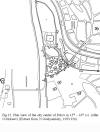 |
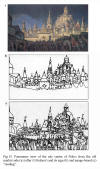 |
Architecture is a reflection, a specific imprint of social and cultural life, using visual means, to translate into the expressive forms of religious and private architecture its main ideas, as well as socio-cultural ideas of national and global value. For example, in the tower palace of czar Aleksey Mikhailovich built in 1668 in v. Kolomenskoye near Moscow by architects A.Petrov and I.Mikhailov, especially on its façades, one clearly sees a collective image of the czar’s family: the principal volume terminating in a decorative spacious shape called “the cube”, where the czar had his summer residence, presents an individual image, “sulky” and somewhat “heavy”. In the transformed architectural forms on the south-eastern façade we see how the czar’s image changes from “head of the state” (“cube”) to “head of the family” in the volume of the tower capped with a roof in the form of a tetrahedral pyramid (“tent”). Behind it, on the left, another volume terminating in two pyramid-shaped roofs, representing the images of “czareviches” (czar’s two elder sons Aleksey and Fyodor). The architectural forms of the north-east façade represent the images of the czar, his spouse Maria Ilyinichna, and his six daughters (fig. 14). This hierarchy, “czar-czarevich” (sons), “czarina-czarevnas” (daughters), is also well perceived within the frame of the whole complex. Based on visualization of the czar’s family image in architectural forms of the palace, an important clarification may be made: contrary to the commonly accepted version that the tower palace included sets of rooms of the czar, czarina, czarevich and four czarevnas, the image-bearing character of its façades and of the whole complex makes us doubt this fact. In fact, by the moment construction of the palace was started, the family of czar Aleksey Mikhailovich included six daughters and three sons. When the fourth son, Ivan, was born in 1666, palace construction had already been underway (Polovtsev, 1992:35).
City Sign- and
Image-Based Reading
Naturally, in all cases considered in this paper, visual perception, i.e., reading architectural and town-planning forms, is realized not at symbol and image levels only. This is done, in the first place, at the sign level (collective unconscious), where signs are the emotional-aesthetic signs based on the emotional content of line-vectors organizing the perceived shape and forming the line-based emotional system of any structure, as well as streets, architectural complexes and city in general (Barabanov, 1992, 1997, 1998). Here, indeed, the temporary parameter of perception plays a more important role. But the main element of the process of perception-reading remains the same.
Since man perceives (reads) the information from his environment through emotional-aesthetic signs, which are the contour lines making up architectural forms and volumes (collective unconscious), and through image-metaphors (individual unconscious). One line-based emotional system gets replaced with the other, and similarly, one image-bearing sequence transforms into the other in the course of consecutive perception-reading of urban shapes and volumes. For example, in “reading” city volumes of Strasbourg, a historically established French city, the viewer’s attention is drawn to strong linear and plastic accents, as well as to image-based accents, created by some buildings in the urban environment, particularly those possessing live and attractive images, such as, e.g., a cathedrals, churches and other public buildings and dwelling houses. The line-based emotional system of buildings in Rue du Mercier, with the Notre Dame Cathedral closing its perspective, begins in the center – a rose window in the top part of the central portal, from which buildings roof and eaves diagonals spread, like radial rays of light, towards the reader-viewer and the frame edges. The aspiration upwards, to God, demonstrated by the majority of the cathedral verticals, is supported by the vertical lines of windows of the buildings looking “eye-to-eye” on each other from the opposite sides of Rue du Mercier (fig. 15-1b). The image-bearing structure of this frame consists of faces – building façades turned to each other and forming a complicated hierarchical-mythological complex, resembling a Medieval artistic-and-philosophical polyptych in the frame center. We see three fundamental symbols in the center of the polyptych: a big square, with an inscribed circle, and a center point, from which radial divine beams emerge like “sparks of divine fire hidden in the matter and brightening it up with the fire of life”.
Here, the clearly visible square symbolizes the Universe – the created space; the circle (circumference), the infinite movement, sky and eternity of the Universe, a symbol associated with the cult of heroes and God. Below the square is a Gothic portal decorated with lancet arches transforming into triangular arrows pointing to the center and “hallowed” by glaring verticals symbolizing entry into the Heavenly City. Over the center, along the façade, in the vertically stretched lancet windows, one reads the images of saints and the Apostles in heaven. The left tower completing the cathedral brings forth the image of the Holy Virgin with Christ Child in her hands, who crowns this expressive composition, full of mythical poetry (fig. 15-1c).
Visual breaking-up of the old enclosure-wall houses in the “wood market square” creates an active line-emotional system, full of verticals, rigid and dynamic diagonals of bars and pointed roofs (fig. 1502b). The image-bearing row of structures of the market square is formed of images-metaphors, representing “salesmen” and “common people” (fig. 15-2c).
In the volumes of the St. Peter church rising upwards we read, at sign level, an idea of upward flight and overcoming obstacles, while at image level, we perceive a small group of stately guards at the city gate (fig. 15-3b,c).
The line-emotional system of a complex of the electrotechnical company buildings bears on a regular geometrical movement from the frame bottom to the center, and back from the center to the right and left, with a vertical upward rise and mystical rhythms coming from the center to the viewer (fig. 15-4b). The image-bearing system of this complex carries an idea of a cosmic complex, with its vertical and transparent cylinders of stairwells resembling astronauts in space-suit capsules, while the transparent façade faces emanating light look like giant divine sculptures (fig. 15-4c).
Sign reading of the France Petite quarter brings forth similar line-emotional series of the old and new parts of the complex, and certain differences at comparison of the image-metaphor series. In the old part of the quarter, in its image-bearing series, we perceive the “face” types of the 17th-18th centuries, and on the contrary, the “gallery” of façade faces looking on the river (in the new part) reflects the 19th and 20th centuries (fig. 15-5, 6).
Dominating horizontals and gently sloping, almost horizontal, diagonal breaks distinguish the line-emotional system of the “Covered” bridge from the system of the Hotel “Department”. In the image-bearing structure we feel a visible temporal difference between the “old craftsman” type in the “covered” bridge, and the “automatic machine” type in the image of the hotel (fig. 15-7b, c).
Similarly, the dynamic to peaceful alternating rhythm of the line-emotional system of the electrotechnical company complex of buildings, with façades lined along Rue du Faubourg de Saverne, together with our perception of the movement from old to new, inevitably expresses the spirit of time, when compared with the “France Petite” residential complex (fig. 15-8b, c). Thus, “reading” Strasbourg brings forth a series of changing metaphorical images based mainly on the “gallery” of anthropomorphic images reflecting the “spirit of time” (fig. 15). In a similar manner the process of perception-reading of shapes and spaces of a new modern city takes place.
Table 4:
1- Rue du Mercier and Notre Dame Cathedral in; 2 – wood market square; 3 – St. Peter church (old) in Rue 22 November; 4 – electrotechnical company’s center; 5 – “France Petite” quarter (old buildings); 6 – “France Petite” quarter (new buildings); 7 – “Covered bridge” and Hotel “Department” (1989), architect C.Vasconi; 8 - Rue du Faubourg de Saverne, with buildings of the electrotechnical company.
Architecture
and Human Behavior
If shapes, lines, planes, colors around a person cause emotional and aesthetic response, architectural-art properties of shapes and volumes may be used consciously, so, definite emotional-aesthetic response and respective behavior of people may be well predicted.
So, in 1994-1999, in the city of Besançon, France, in the Brulard residential area, an architectural-sociological experiment was carried out for capital architectural refurbishment and rehabilitation of the whole residential quarter HLM, which included three long tall buildings and a school built at the turn of 1960. Inevitability of apartment houses rehabilitation was caused by the pressing need for radical changes and liquidation of the social tension which had been felt since the end of the 80s in this quarter, inhabited mainly by immigrants from the Maghrib countries. In the general situation of rather quiet social environment in Besançon, with the population of about 140,000 people, the greater part of breaches of peace, as well as crimes, occurred in this quarter located in the new part of Besançon, beyond the boundaries of its historical nucleus. For solving the problem, a group of sociologists was formed, which, with the participation of a sociologist, Mr.Dodane, developed and implemented a whole set of measures for refurbishment and rehabilitation of the quarter, after it had been established that the cause of all social troubles were shortcomings in architecture. In the town-planning studio of architect Philippe Lamboley, a project was designed, envisaging considerable change in both the exterior and the interior of the then existing houses: architectural re-planning of apartments, their modernization, improvement of vertical and horizontal communications, underground parking areas, etc. House façades changed radically: instead of the smooth surfaces spotted with windows, new fragmentations, commensurate to man and small human groups, were introduced in the form of plastically accentuated entrance doors, overhead galleries – they improved the exterior and strengthened horizontal communications. The top part also changed: a metal dome appeared over the roof of one of the buildings. Another building was cut diagonally and also acquired galleries serving as horizontal external communications. In the third apartment house, rectangular arches for passage of considerable sizes giving access to the yard spaces inside the quarter were cut (fig. 16).
Refurbishment and rehabilitation of the quarter exceeded all expectations: abrupt decrease in the rate of breaches of law was noted, despite that the contingent of the quarter residents changed but very little.
At present, the Laboratory of architectural-art semiotics of the Ural State Academy of Architecture and Arts (USAAA) is working on an international research project “Architectural Properties of Public Spaces in Ekaterinburg” supported by INTAS. The project includes the investigation of 22 typical public spaces important for the city from the point of view of their morphology and architectural-art characteristics in connection with social behavior of people. Semiotic analysis of interrelations of the architectural-art properties of these spaces and people’s behavior is carried out using the technique proposed by the project coordinator, architect-semiotic Pierre Pellegrino, Switzerland, and the technique of application of semiograms designed in the Laboratory of architectural-art semiotics of the USAAA. The technique in question consists in plotting and application of behavior semiograms, in which, by means of photographic registration in certain points of the investigated space (with account for time of the day, day of the week – workdays or holidays, and seasons), relations are established between the characteristics of people’s behavior and characteristics of typological people’s behavior, with the use of the database and the selected scale of the investigated spaces. Closeness or absence of points-indicators of behavior, displaying the regularities and characteristics of people’s behavior, to points of morphological insufficiency established at morphological analysis of architectural properties of public spaces would allow us to judge about direct or indirect influence of the latter on people’s behavior, and offer recommendations for improvement of morphological parameters of the investigated public spaces with a view to correct people’s behavior and making urban environment socially comfortable.
Notes
[1]
Geometrical symbolism of
Parthenon is supplemented with number symbolism: Doric pillars surrounding the
temple cella, lined by 8 in the external side rows,
symbolize and amplify cosmic equilibrium, rebirth and transformation;
longitudinal rows along the southern and northern façades include 17 pillars
each, which symbolized 17 consonants of the Greek alphabet of the Ancient
Greeks; in its turn, this number was divided to 9 (the number of voiceless
consonants) and 8 (number of semi-consonants or semi-vowels) which were closely
related to the musical theory and harmony of spheres. Longitudinal internal
rows of Doric pillars surrounding the cella of the
temple dedicated to goddess Athene Parthenos had 9 pillars along each side (Chevalier et Gheerbrant, 1988:511, 361).
[2] The pantheon of Slavic gods (formed by 980 in Kiev Russia, during reign of prince Vladimir) included: Perun – god of thunderstorm (thunder), patron of warriors, supreme deity in the Kiev Russia pantheon; Stribog – god-patron of peace; Sventovit (Svyatovit) – supreme deity of war and victory; Dazh'bog – son of the god of fire Svarog, thus often called Svarozhich, the main giver of wealth; Mokosh – goddess who personified humidity, water and wet Mother-earth; Khors – sun god, associated with the sun; Semargl (Simargl) – god associated with the sacred meaning of the figure of 7; Svarog – the god of fire; Veles (Volos) – patron god of domestic animals (Petrukhin, 1995, 1996).
- translated by Marina Yakhontova -
References
Alferova
G.V, Kharlamov V.A. 1982 Kiev in the second half
of 13th c. Kiev: Naukova Dumka.
Barabanov
A.A. 1991 Semioticheskie problemy v khudozhestvenno-kompozitsionnoi
podgotovke arkhitektorov
// Khudozhestvenno-kompozitsionnaya podgotovka arkhitektorov i dizainerov.Sverdlovsk: SAI.
Barabanov A.A. 1992 Semioticheskie
problemy formoobrazovaniya
v nachalnom obuchenii arkhitektorov //Problemy arkhitekturnogo obrazovaniya (nachalny etap obucheniya). Rostov-on-Don:
RAI.
Barabanov
A.A. 1999а Chteniye goroda // Semiotika prostranstva (edited by
A.A. Barabanov). Ekaterinburg:
Arkhitekton.
Burton R., Cavendish P., Lederer B. 1995 Atlas chudes sveta. Vydayushchiesya arkhitekturniye sooruzheniya i pamyatniki vsekh
vremen i narodov. M.: VMM AO.
Bauer Wolfgang, Dumoc Imtraud, Golovin Sergius. 1995 Entsyklopedia simvolov,
Moscow: Kron-Press.
Belyaeva E.L. 1977 Arkhitekturno-prostranstvennaya
sreda goroda kak obyekt zritelnogo
vospliyatiya. Moscow: Stroiizdat.
Brinkmann A.E. 1935 Ploshchad i monument.
M.: VAA Publishers.
Bunin A.V.. 1979 Istoriya
gradostroitelstva rabovladelcheskogo
stroya i feodalizma. M.: Stroiizdat.
Vazari
Giorgio. 1956. Zhizneopisaniya naiboleee zamechatelnykh zhivopistsev, vayatelei i zodchikh. V.1.
M.: “Iskusstvo”.
Vinogradov V.A. et al. 1996 Moskva 850 let. V.1.
M.: AO Moscov ucheb.
Volodikhin D. 1995 Istoriya Rossii. V. 5. M. :
Avanta +.
Vygotsky L.S. 1986 Psikhologiya iskusstva. Moscow.
Goulyanitsky N.F. et al. 1993 Russkoye
gradostroitelnoye iskusstvo. Drevnerusskoye gradostroitelstvo X-XVvekov.
M.: Stroiizdat.
Ikonnikov A., Stepanov G. 1971 Osnovy arkhitekturnoi
kompozitsii. Moscow: Iskusstvo.
Ikonnikov A.V.. 1985 Khudozhestvennyi yazyk
arkhitektury. Moscow: Iskusstvo.
Komec A.I., Podobedova O.I. 1988 Drevnerusskoye
iskusstvo. Khudozhestvennaya kultura Х – pervoi
poloviny XIII v. M.: Nauka.
Korotkovsky A.E..1975 Vvedeniye v
arkhitekturno-kompozitsionnoye modelirovaniye, Moscow: MArkhI.
Le Courbusier
1924 New epoch in architecture (from report read in Sorbonne on 12 June 1924.//Arkhitektura
sovremennogo Zapada (edited
by Arkin D.) Moscow: Izogiz, 1932.
Mokeev G.Ia.1978 Mnogoglavye
khramy drevnei Rusi //Arkhitekturnoye nasledstvo, M 26. Traditsii i novatorstvo v zodchestve narodov SSSR.
M.: Stroiizdat.
Strautmanis I.A. 1978 Informatsionno-emotsionalnyi
potentsial arkhitektury. Moscow:
Stroiizdat.
Simonds
John O. 1965 Landshaft i
arkhitektura, Moscow: Stroiizdat.
Khrapchenko M.B. 1982 Khudozhestvennoye
tvorchestvo, deistvitelnost,
chelovek. 3rd
ed. Moscow: Sovetskii pisatel.
Ozhegov
S.S., Proskuryakova T.S., Khoang
Dao King 1988 Arkhitektura Indokitaya. M.: Stroiizdat.
Ozhegova N.I.. 1988 Iskusstvo
Birmy. M.: Izobr.
iskusstvo.
Petrukhin V. 1995 Slavyanskaya
mifologiya. M.:Ellis Lak.1996 Slavyane. M.: Rosmen.
Polovtsev A.A.. 1992 Aleksei Mikhailovich // Russkii
biograficheskii slovar.
V. 2. M.: Aspect Press LTD.
Toporov V.N..1994 Drevo mirovoye.
Gora.
Kvadrat // Tokarev S.A.. Mify narodov mira.
Entsyklopedia. V. l. M.: Ros. entsykl.
Toporov
V.N. and Meilach M.B..1994
Krug // Tokarev S.A. Mify
narodov mira. Entsyklopedia.
V. 2. M.: Ros. entsykl.
Uspenski B.A. 1995 Semiotika
iskusstva. M.: Shk.
"Yaz. Rus. kultury".
Ushakov Yu.S.1982 Ansambl v narodmon zodchestve russkogo severa. L.:
Stroiizdat.
Shmelev I.P. 1990 Tretya signalnaya sistema // Zolotoye secheniye. Tri vzglyada na prirodu garmonii (I.Sh.Shevelev, M.A.MArutaev, I.P.Shmelev). M.: Stroiizdat.
Barabanov А.А. 1997 Méthode sémiotique de l'étude de
la composition dans la formation primaire des architectes à l'école
supérieure// Architecture, sémiotique et sciences humaines. Topogenèse Barcelona:
Edicions UPC.
Barabanov
A.A. 1998. Semiotic Fundamentals of the Language of Architecture // The Man and the City: Spaces, Forms,
Meanings: Reports to the International Congress of the International Association
for the Semiotics of Space (St. Petersburg, 27 – 30 July 1995). In 2 v.
V.II (ed. A.Barabanov). Ekaterinburg : Architecton.
Barabanov А.А. 1999b La sémantique des processus de l'interprétation visuelle en
architecture. Les actes du VIle Congres International de Sémiotique (IASS-AIS)
“Sémioses dans les Systèmes Complexes ”. Dresden.
Barthes, Roland 1970 Sémologie et Urbanisme. Architecture
d'aujourd'hui. № 153.
Chevalier Jean et Alain Gheerbrant 1988 Dictionnaire
des symboles: (mythes, rêves, coutumes, gestes, formes, figures, couleurs,
nombres), Paris: Robert Laffont/Jupiter.
Hugo, Victor 1925 Notre-Dame de Paris. Paris: eds.
J.Hetzel & Cie et Maison Quantin.
Janson,
Horst Woldemar et Anthony F.Janson 1986 History of Art. Third ed. New York: Harm N.Abrams, INC.
John Ormsbee
Simonds 1961 Landscape Architecture.
The shaping of man’s natural environment New York: F.W. Dodge Corporation.
Lagopoulos, Alexandros - Ph. 1995 Urbanisme et
Sémiotique dans les sociétés pré-industrielles. Paris: Anthropos.
Novgorodowa, Eleonora 1980 Alte Kunst der Mongolei,
Verlag. Leipzig: E.A.Seemann.
Racinet Albert 1995 Histoire du costume. Paris:
Booking International.
Stierlin,
Henri 1979 Encyclopaedia of Word
Architecture. V. 2. second edition. Lausanne.
Stierlin,
Henri 1997 The Maya. Palaces
and pyramids of the Rainforest. Kôln: Benedikt Taschen Verlag GmbH.
Tange, Kenzo 1979 Works of Kenzo Tange and URTEC. Tokyo:
The Japan Architect.
